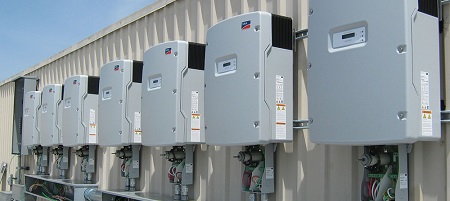String inverters can have a number of advantages over central inverters in commercial, industrial and small utility projects. This is especially true with the introduction of high-power 1,000Vdc, 3-phase 480Vac string inverters.
“1000Vdc arrays have significant wire and labor savings compared to 600-Vdc arrays of the same size,” explained Eric Every, senior applications engineer at Yaskawa – Solectria Solar. “Because the voltage is higher, the current is lower. Current drives cost because more current requires larger conductors.
Therefore, 3-phase, 480Vac is an extremely common service voltage in the U.S. Anything else is perceived as special use and may have a higher cost and longer lead time.”
“Now that more 1000Vac-rated equipment—such as modules and BOS components—is available, inverters with an input voltage that can use those longer strings are needed,” added Brian Lydic, Standards & Technology Integration engineer at Fronius. “This reduces wiring cost and can increase the efficiency when converting to 480Vac. Most commercial and industrial buildings use 480-Vac service, so it’s a typical low voltage configuration available from distribution transformers. The rapid shutdown requirement of NEC 2014 can also drive adoption of distributed string inverters for rooftops, where they can be placed within the 10-ft array boundary.”
String inverters also offer cost benefits when commissioning, operating and servicing commercial and small utility projects.
“The initial capital cost for central inverters is lower,” said Chavonne Yee, director of product management for ABB North America. “However, the cost of transportation and installation, including site preparation, must be factored in to the cost. Many string inverters are able to mount on the module racking with no added cost for site preparation. The commissioning time for string inverters is also less, as much smaller blocks of power are brought on. String inverters by design are smaller blocks of power that, in case of failure, have a much smaller effect on lost energy production.”
Martin Beran, head of system support in Fronius’s Solar Energy Division added that string inverters can have communication benefits, outweighing those of central. “Centralized communication and grid features control has been an advantage for centralized topologies, but enhanced network capabilities of string inverters now mitigate that benefit.”
Getting the most benefits from string inverters also depends on design.
Lydic encouraged developers to consider placement of the inverters within the array to easily facilitate operations and maintenance, such as proximity to access pathways and grouping of inverter banks. “Pay attention to minimizing AC voltage rise in your conductor runs to the transformers,” he said. “Repeatability of the string and subarray design and location will help minimize installation effort.
String inverters are also well suited to be sited with central inverters when a site’s power requirements are in between integers of central inverters, allowing for power production without investing in a central inverter that will be under capacity.
“Central inverters still prove their spot in the PV industry, but string inverter applications proved their advantages in pretty much all type of installations up to 10MW,” concluded Beran.
Published here by the PVBUZZ team from the original article written and edited for publication on Solar Power World Online by Kathie Zipp.












Comments